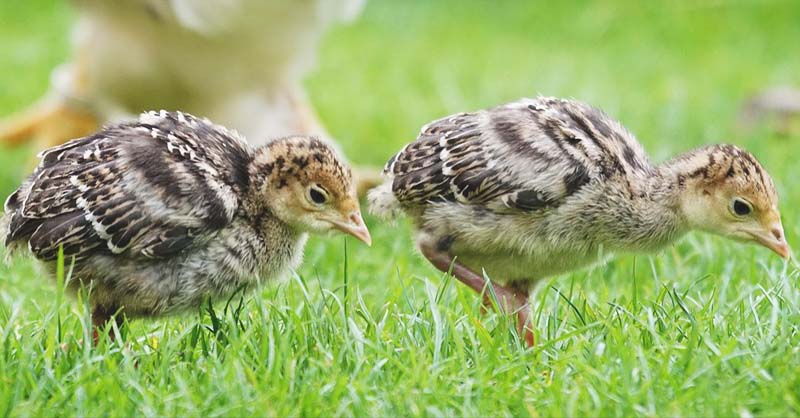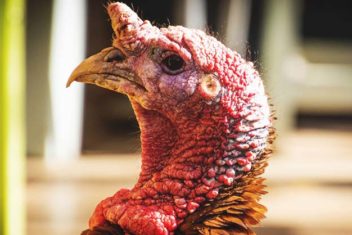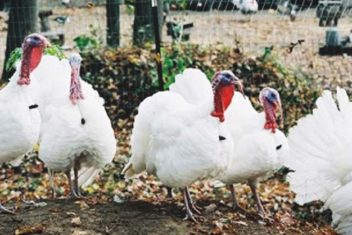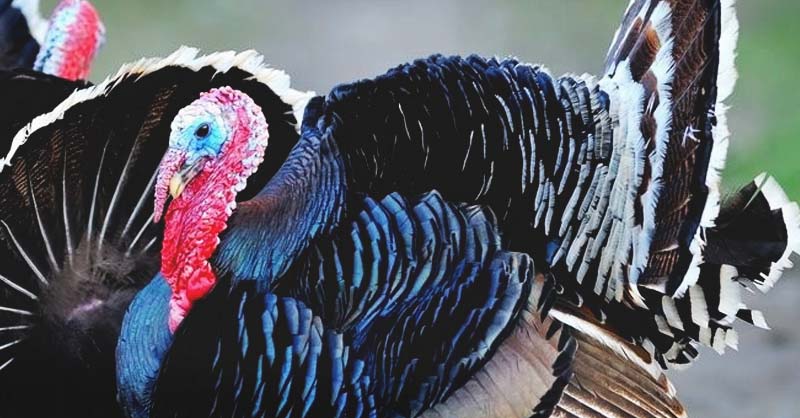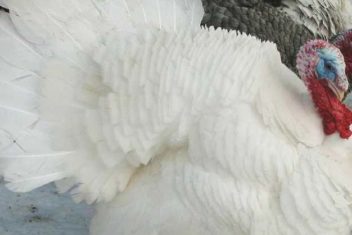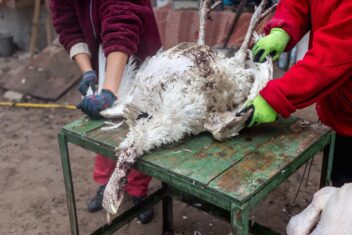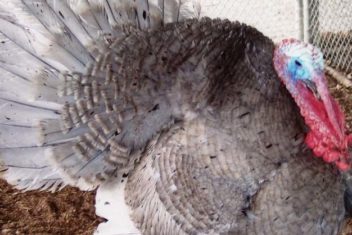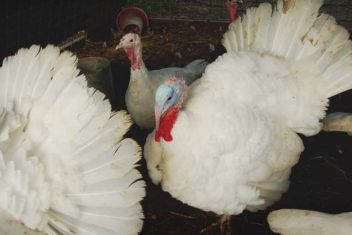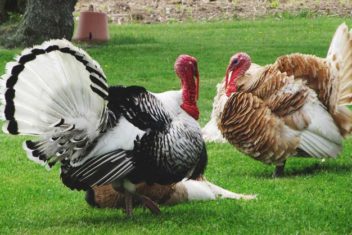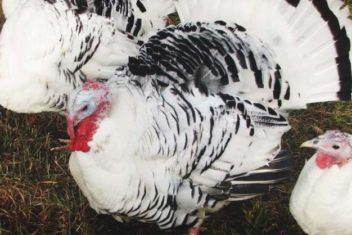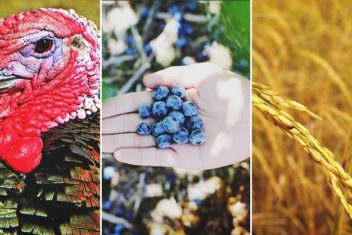Does raising turkeys sound like the logical next step for your homestead but rumors of their high mortality rates are giving you second thoughts?
Several years after raising Cornish-crosses for meat, we decided to be adventurous and give turkeys a try. How hard could they be compared to chickens, we innocently thought.
With giddy excitement, we requested five Royal Palms Turkeys with our standard order of chicks.
We’re a busy family and always scouting for ways to save time. So when we brought our new poults (turkey chicks) home, we gently placed our poults and chicks in the same brooder pen.
What we didn’t realize was by mixing our chicks and poults, we committed a big no-no.
Now, research is important and I’m the last to suggest rebelling against solid advice. But looking back I’m glad we didn’t know better. Here are five reasons why.
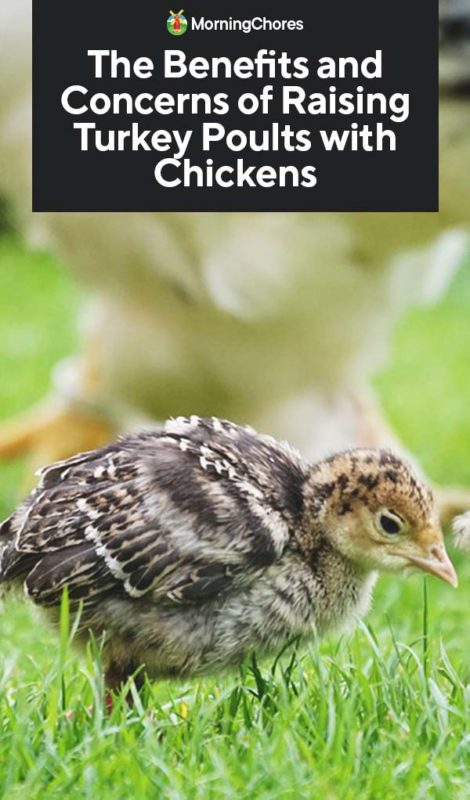
1. The Chicks Teach The Poults
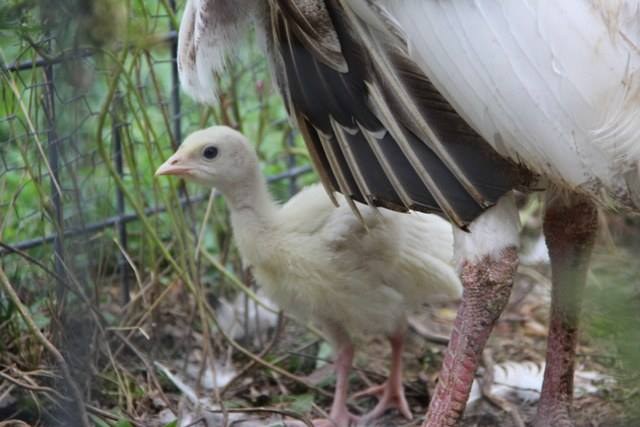
Remember we were naive about how difficult turkeys are to raise, so we simply treated them like the chicks.
We dipped their beaks in the waterer for their first drink and sprinkled chick starter on a paper towel to stimulate their interest in food. We watched to see if they huddled together signaling they were cold or if they panted from being too close to the heat lamp.
Now that I know turkeys poults require higher heat than chicks, and for a longer period, I think part of our success is that we were already cautious with our chicks.
We raised them in a designated room and near a woodstove. Because it was near the house, we checked them frequently, meaning if the turkeys showed signs of distress we were on it.
In truth, though, the credit goes to our poults’ chick peers. The chicks taught the turkeys how to thrive.
We had about 25 chicks to five poults, so apparently, it took 5 teachers per student but they learned to eat, drink, and scratch the bedding through show and tell.
2. Calms The Chicks
The benefits are far from being a one-way street, though. Turkeys are laid-back creatures. Even their unique peep peep peeps have a calm, gentle tone to them.
This spread to the chicks; they did not startle or take off in fear-flight as often as our previous flocks had. We surely appreciated the soothing influence the turkeys provided!
3. Maximizes Chore Time and Efficiency
As I said before, efficiency is a must for our family. Caring for all our poultry at one time was a tremendous plus for us.
This freed our focus on the flock as a whole, not to mention saving us the rigamarole of trying to remember if we missed feeding one of our flocks.
4. Requires Less Space
Space is a big deal for many homesteaders. Every inch counts on our little homestead, especially since we do pasture poultry which entails our portable pens being moved on a daily bases for fresh forage.
This alone made raising turkey poults with chickens a win. Once temperatures were warm enough to boot them outdoors, we continued raising turkey poults with chickens and were delighted to have only one pen to move instead of two.
5. Multi-purposed Our Equipment
As mentioned in point 4, our system for raising poultry is the pasture method. Adapted from Joel Salatin’s Pastured Poultry ideology, our chickens are grown in portable pens or “tractors” once they are strong enough to move outdoors.
Naturally, the more purposes you get out of your equipment, the better. You save time and money building and then maintaining a special turkey pen; you save daylight hours moving a separate pen, and like in the chick stage, you save time and energy chore-ing because everyone is at the same place.
Why Raising Turkey Poults with Chickens Are Discouraged
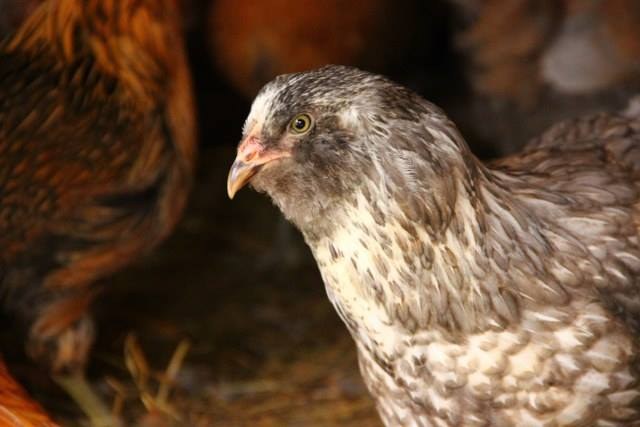
By now, you’ve likely guessed I’m sold on the benefits of growing poults and chicks together. However, there are valid concerns with raising turkey poults with chickens.
1. Risk of Blackhead Disease
Blackhead disease could have made our experiment a sad ending. When asking the question “Can you raise chickens and turkeys together?” in your search bar, scores of articles about Blackhead disease will pop up. It’s a severe disease often fatal to turkeys.
Yet, obviously it can be done. What makes the difference?
First, let’s look at a few considerations with Blackhead disease.
Separation Is Not Foolproof
There is no way to completely remove the risk. Histomonas Meleagridis (Blackhead disease) is a protozoan whose host is a parasitic cecal worm egg (yes, disgusting). Chickens may carry them but usually, do not show signs of the disease and are not as vulnerable to its effects. Turkeys, on the other hand, are very susceptible to Histomonas Meleagridis and rarely survive it.
However, chickens are far from being the only hosts. Even earthworms can ingest the eggs and thus transmit it to the turkey who completes the food chain by gobbling on an earthworm.
If you live in an area where the disease is prevalent, separation may be your wisest option. According to my local extension office and from personal experience, Blackhead disease is not widespread in our Midwest state.
Ask your vet, university extension office, and fellow homesteaders their experience with Blackhead disease and its presence in your area.
In addition to their advice, here are tips that worked for us.
Only Buy Young, Healthy Birds
Our chicks and poults came straight from the hatchery and into their own room. We never mixed them with poultry not raised on our homestead.
Also, research suggests broiler breeds, such as Cornish-crosses, are less likely to carry the disease. Here is why.
It takes about a month from the time the poultry are moved outdoors for them to shed the disease. Since most broiler chickens are processed between 8-12 weeks of age, this significantly lowers their chances of contacting and then spreading Blackhead disease.
Even when our turkeys were grown and released to forage in the barnyard with our laying flock, we never once had an outbreak. Again, we rarely buy adult chickens, preferring to raise them (and even better hatch them!) ourselves.
If I bought adult chickens I’d never introduce them to turkeys – or any other members of my flock – until after a very long quarantine. Even then you’re still taking a risk, so starting with young ones is the ideal scenario all around.
High-quality feed
In addition to healthy fowl, we are picky, picky, picky about our poultry feed. Because guess what, when you raise your own meat – what they eat is ultimately what you eat. We buy quality, natural feed to give our poultry a nutrition-rich diet and help our healthy flock stay a healthy flock.
Pasture
As already mentioned, we’ve had great success daily moving our poultry to fresh pasture (and as they need it even twice a day). How does this discourage the risk of Blackhead disease?
One, it allows our poultry to live as they were created to live. Chickens and turkeys don’t run in dirt pens day in and day out in the wild.
Their well-being is dependent on scavenging new pasture as they scout for insects, worms, and bugs. Mimicking nature lowers stress and risk for stress-related illnesses.
Two, moving them daily gets them out of their sewage. The health benefits this provides are obvious, but one great advantaged is the life cycle of pathogens is interrupted, which works against the survival of our Blackhead disease protozoan culprit.
Guarding the health of our poultry, not feeding them what we wouldn’t eat, and fresh pasture are reasons I believe we didn’t have disease issues with our chickens and turkeys.
Obviously, this is based only on my personal experience; I can’t encourage you enough to do your research and make the decision that is best for your flock (or flocks as you may decide).
2. Adult Turkeys Can Be Hard On Chickens
Contrary to the normal scare of turkeys being exposed to diseases chickens carry, the couple of times we had issues was the fault of the turkeys and only after they were big and grown.
Because turkeys are so much more substantial than chickens, we did have one or two cases where the turkeys trampled a couple of our hens, which was the ultimate reason for why we separated them into their own area.
Of course, this isn’t a problem if you purchase your chicks and poults at the same time and then separate them before the turkeys are fully grown. Since we process our Cornish-crosses at 10-12 weeks, this only became an issue when we moved the turkeys in with our layer hens.
3. Different Protein Requirements
It is true turkeys require a higher protein source than chickens do. In our case, we fed a flock raiser designed for meat birds and did not have any issues. Forgive me for making another plug for natural feeds, but I believe this played a huge factor in our success.
If you’re still concerned about your turkeys getting enough protein, you can always separate the poults once a day and feed them chopped boiled eggs (shell and all). It should be enough to meet their higher protein needs without making your chickens consume more protein than is healthy for them.
The Conclusion of Raising Turkey Poults with Chickens
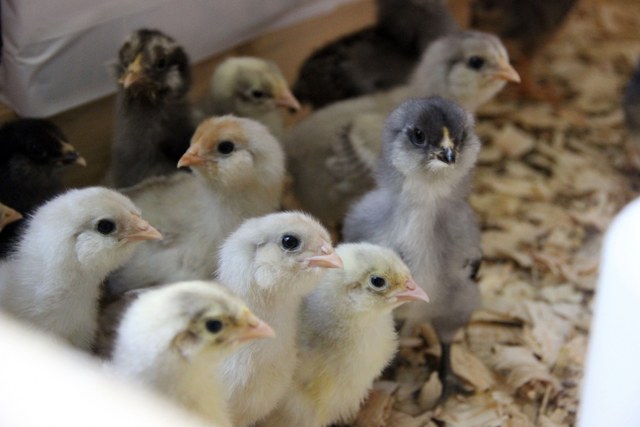
Now you have them: the reasons why raising turkey poults with chickens does work. Hopefully, this will ease hesitations you may have had or give you the research tools you need to reach the best decision for you. Our experience isn’t for everyone, but we are glad we gave our little turkey peepers a chance.

